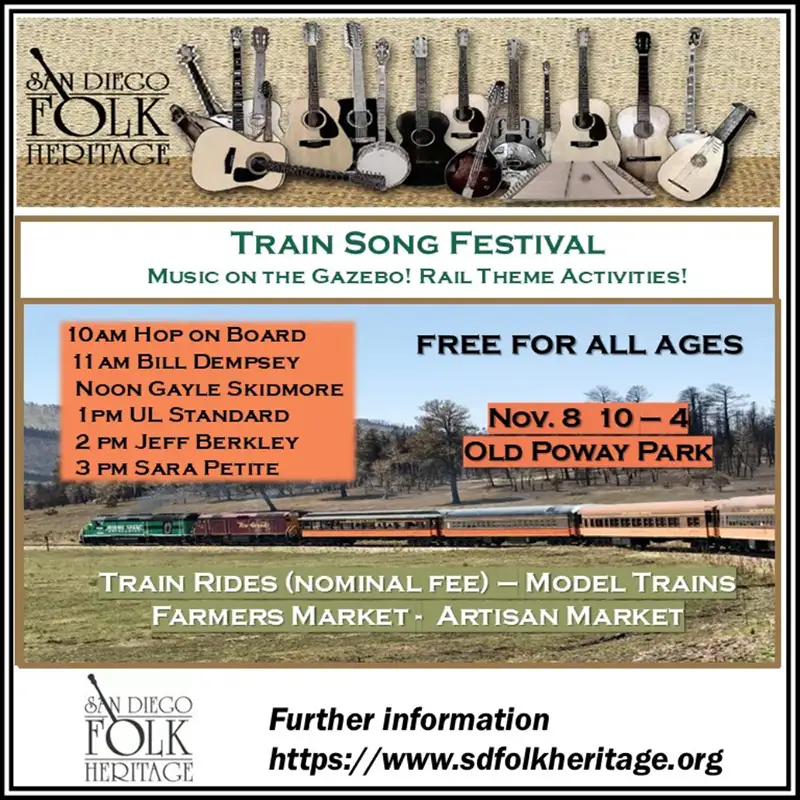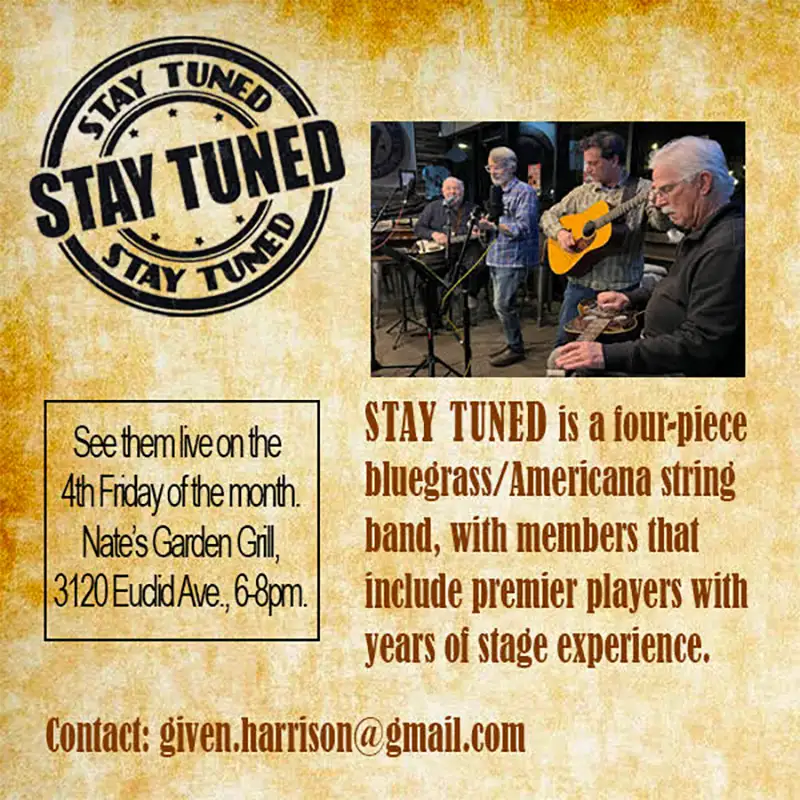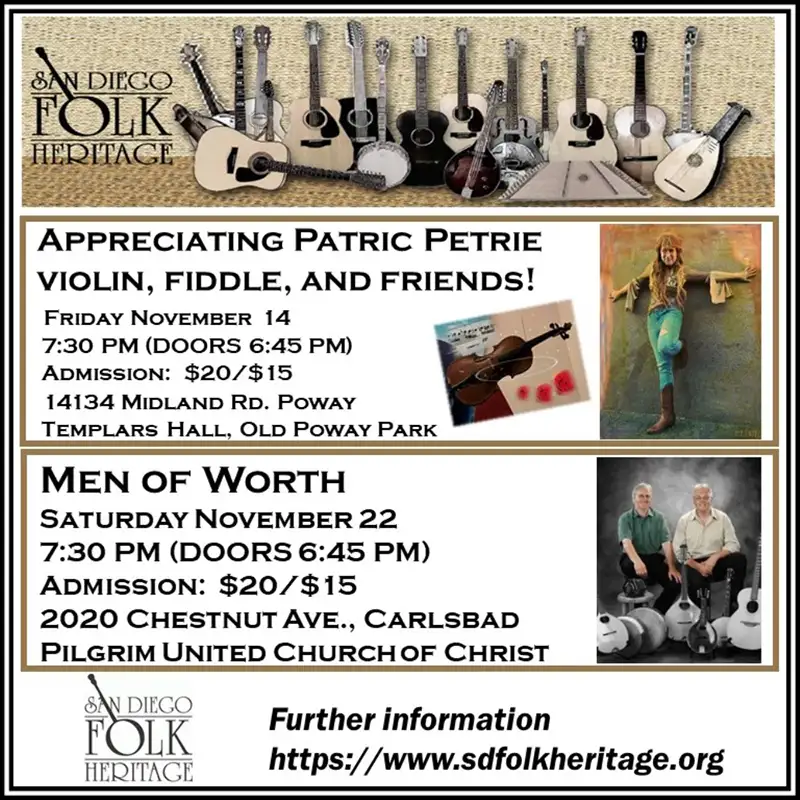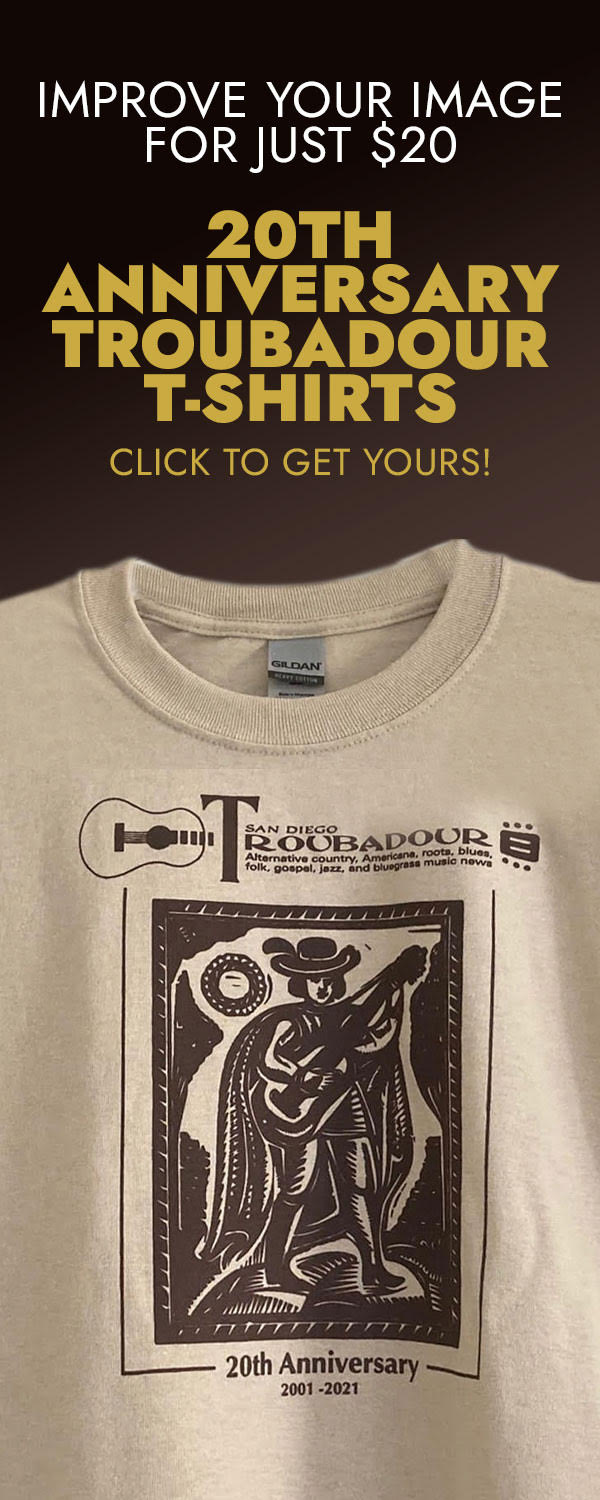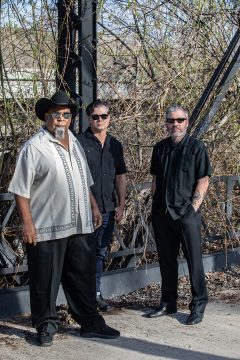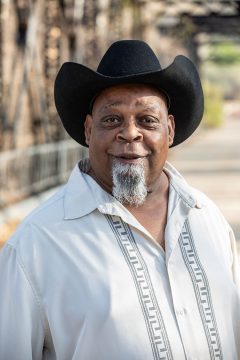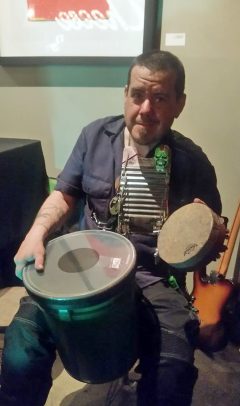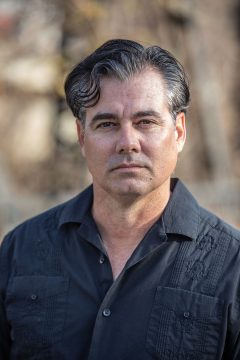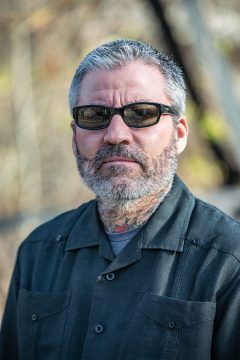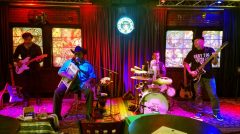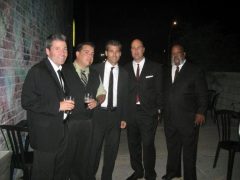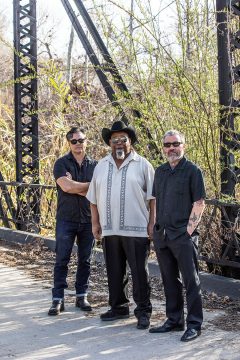Cover Story
The Fremonts Find Their Niche: One-Chord Swamp Grooves for the Masses
When you hang with the Fremonts it becomes obvious almost immediately these guys operate on the same frequency. They’re connected like brothers, both on and off the stage. In conversation, they finish each other’s sentences and, even trippier, during live gigs they’ll occasionally trade off instruments. Over the past 20 years the lineup has changed very little, but former members are always welcomed back to sit in, because they tell me, “we’ve become family.” Today’s roster includes guitarist Tony Tomlinson, bassist Patrick Skog, Alan West on drums, and Mighty Joe Milsap on vocals and percussion.
What separates the Fremonts from other blues bands is their unique style of play and their approach to the genre. “Our thing, if we have one,” says Pat, “is one-chord grooves that rely on space.” Heavily influenced by the Excello and Chess labels, you’ll hear covers of Frank Frost, Lazy Lester, and Slim Harpo as well as original compositions that reflect that same raw intensity. Their sound is distinctive, filled with swampy, voodoo rhythms laced with the grit of Chicago’s Southside amid trace amounts of Texas roadhouse and West Coast mojo. The Fremonts are a true gumbo of American blues.
We gathered, at a distance, to talk about the band’s unique perspective on blues and how they remain so consistent in producing their brand of music.
Our conversation began with vocalist Mighty Joe Milsap and how the band originally came together.
“Tony and Pat had the idea based on music that nobody else was doing around here at that time. I was a school bus driver and Kurt Kalker was the drummer back then. I ended up going to a jam session one day to sing and they liked my tone. The next thing I knew Tony was calling me up and asking me to come and sit in as a guest. They asked if they could give me a few more songs to learn, then we got a studio and started practicing. Our first gig was at Blind Melon’s.” Tony Tomlinson nods, “Yep, Blind Melon’s, where they used to have a featured artist showcase. They asked me to do a Tuesday night or a Thursday night and I didn’t have a band, so I just got together guys I knew and that ended up being the Fremonts now…and, of course, Joe sang with us.”
Who was in the original line-up?
“It was Kurt Kalker, Tony Tomlinson, Patrick Skog, myself, Kevin Spellman, and Smedley B. That was in about 2000…2001.” says Milsap. “After Spellman and Smedley left we pulled in Troy Sandow.” Guitarist Patrick Skog adds, “It was myself, Tony, and Joe; we had a couple of guys that were in and out quickly, and then we brought Troy in and that was really the core of the band for five or six years. When Kurt left, Alan West joined us on drums and he’s been with us now for, like, 12 years or more. And then Troy sort of just meandered off and started playing with Nathan James. Essentially, the Fremonts have been the four of us and Troy comes in and out, for 14 years.”
So, once you’re in the band, you’re always in the band?
“They still come back and play.” Pat says. “If Kurt’s in town he’ll come back and sit in or play congas or something like that.”
Fremonts’ drummer Alan West remembers his introduction to the Fremonts.
“Well, I got a call from Tony—I think it was in 2004—to perform a show in San Diego with the Fremonts. He said, ‘Just show up and I will have drums.’ At the time I was in the James Harman band and didn’t know much about the Fremonts. So, I went down on my motorcycle and had a great time. They were fun to perform with and I really liked Joe’s timing on percussion. Blues is such a great art form where each person has space. Tony, Pat, and Joe are all on the same page and know exactly where to be.
Since everybody was playing West Coast blues, we
thought we need to have our own thing.
We needed a niche, and swamp blues filled it—
the sound of the early to mid-’50s to early ’60s.
—Tony Tomlinson
When you look through the Fremonts discography, you notice a number of guests that appear on your recordings.
“There are a lot of musicians we know who will play on our albums and sit in with us, including Jonny Viau and Sonny Leyland, but the core band is the four of us.”
Not that many bands stay together for 20 years. How do the Fremonts manage to do that?
Pat says, “I think probably the reason we’ve stayed together for this long…” Joe finishes his thought, “We get along! For some strange reason, we’ve never really had any arguments that I can think of, you know?” Joe grins, “I may have gotten a little hot-headed sometimes…when I was taking some medicine, you know?” Guitarist Tony Tomlinson [laughing] interjects, “I think we’ve lasted this long because when we have an idea about what sound we’re trying to accomplish, Joe isn’t your normal singer. When we write, we write for him and I think that combination has worked. All of us have played for some time and with other bands. In the Fremont’s we get to do whatever we want and we settled on a sound that was different.”
Describe your style of music.
“It’s a Baton Rouge influence, but we don’t sound exactly like the Excello stuff or the Baton Rouge stuff, it ends up morphing into…us. When we formed the band, everybody was playing West Coast stuff. We’re not freaking Rick Holmstrom, Junior Watson, or Hollywood Fats, you know what I mean? You shouldn’t try to be like that; they’re their own thing. Since everybody was playing West Coast blues, we thought we need to have our own thing. We need a niche, and swamp blues filled it. The sound of the early to mid-’50s to early ’60s…like Slim Harpo’s band when he was making all the hits like ‘Still Raining in My Heart,’ ‘Mohair Sam,’ and all those things. They had guitar players that played guitar and bass, just like we do. That really starts to shape the sound when you do that.”
Is it fair to say the Fremonts are a blues band?
“I think we get criticized for not having more of a rock influence,” Pat says. “It’s funny. People say our niche is ‘more traditionalist, or that we’re more this or that.’ I think the biggest thing about the Fremonts is not what we’re playing; it’s what we’re not playing. We settled on the notion of space and that’s what Alan does really well on the drums. If you come and see us play, everyone’s playing a part, nobody’s stepping over each other, and we try to leave a lot of space in the music for Joe’s vocal. We don’t have any effects, the effects the band uses is a tremolo on the guitar that creates space and some people don’t understand that. We’ve had people come up and say, ‘You guys just need to just RIP it and go for it!’ We’re not blues rock, that’s not us. We’re traditionalists in that sense. And that’s always been our approach.
“I think when we found ourselves as a band, when you start off you’re trying to figure out how to play the songs and I think what we’ve been really good at is having a really tight filter. If we don’t do something well, we’re just not going to do it. Maybe if Tony plays this song really well or Pat plays this song really well but it doesn’t fit the sound of the band or the vocal, we’re not going to do it. It’s like when you go to a movie, a classic genre piece, you don’t want to see someone walking out with the wrong outfit on. That’s kinda’ our approach. And even our writing has molded to that.”
Well, since you mentioned it, can you talk about your approach to writing?
“We write together and we come up with ideas. Tony will have an idea or I’ll have an idea. We’ll piece some songs together, or we’ll have a guitar part or a vocal part and we just mash things together. But again, it’s really difficult to write in the genre because we put such tight restraints on ourselves. I know that I’ve probably written 20 songs that will never see the light of day because they just don’t fit with what we do.”
A dreamy little taste of the Fremonts!
https://www.facebook.com/TheFremontsBluesBand/videos/1057135741163507
The Fremonts also perform a number of terrific and sometimes obscure covers during a set. How does that happen?
“Our material, especially when Troy was with the band, we became like musicologists and archivists for a long period of time and we were passing and buying CDs and trading things. This was before everything ended up on YouTube. We actually pre-dated that. We would make trips to the record stores, buying CDs and pass them back and forth, and that’s how we got the Frank Frost stuff…and kind of dug into the weeds. Everybody knows the common material, but when you dig deeper and if we do this stuff well and it fits Joe’s voice…we do space and parts well, so we won’t come across like a British blues band; we’re not over the top, flaming guitars…”
You found your niche.
“Thunder niche! [laughing] When we made our first real record with Mark Neill, he was influential as well,” Tony says. “We had played a song, ‘Come to Mighty Joe,’ and we had recorded for a couple of days. Pat started playing the groove and Mark immediately heard where we were going with it. And he made Pat play this ridiculous bass with massive strings way back on the bridge for hours. Now, you’re on to something and you sound like you. It was that greasy, swampy, big one-chord, muscular groove that really became an identifier. And he heard it. He heard us playing a lot of stuff but once he heard us pull that out—that’s what you sound like—that’s what the Fremonts are! That was from the Mighty Crazy album. Working with Mark pushed us in a lot of different ways. It was difficult but he taught us lots of things about being professionals and trying to form a sound and especially with recording. Obviously, he’s a Grammy-winning producer.”
***************
Mark Neill is in fact, an award-winning engineer/producer and artist. He’s worked with everyone from the Black Keys and the Oak Ridge Boys to Deke Dickerson, Billy Bacon, and the Paladins. I asked Neill how he ended up working with the Fremonts.
“Well, Tony reached out and was asking me technical questions about one of my previous recordings, and I said, ‘Why don’t you come in and make a record?’ and you need to do it pretty quick because I’m fixing to leave. Bless his heart, he’s such a sweet guy and he said, ‘Alright I’ll put it together.’ And he talked to his band, put his best foot forward, and just did it. They came in and cut Mighty Crazy, which I thought was a really good record. You know, Joe (Milsap) is such a sweetheart and it was so easy to work with him. That’s one of my favorite records and they’re some of the few people I miss out there.”
As a producer, you seem to have an affinity for old amps, guitars, and recording techniques.
“That’s just because that’s what I know how to use. [laughing] Honestly, where I grew up in Georgia the sound was from the ’40s and ’50s, and when I was 12 I started hanging around WVLD radio and their production recording studios. I got my FCC license when I was 14. So, when Tony and I agreed to do Mighty Crazy we were like, how cool would it be to have every variety and every era presented on one record. Almost like a concept compilation album from the old Chess or Excello days only with one band covering those sounds. Tony and I had a ball doing that. They’re like folk blues so no matter how you slice it. If it’s slightly Cajun, slightly more Chess, it doesn’t matter—they’re folk blues and that’s huge because Joe’s the guy that brings the authenticity, he’s the guy that brings that.”
***************
Tony, I know we’ve spoken before about influences, how has touring affected the band?
“Everybody plays the same spots,” he says. “And before the music died there were venues that were real popular with the roots music scene, the blues, swing, and the rockabilly scene all travel the same circuits and you see the same people over and over. And Al was playing in the James Harman band ensemble and Harman was a big influence on us. He was an easy fit when he came over. Seeing bands like Big Sandy and the Fly-Rite Boys puts a lot of pressure on the rhythm section because they’re so great. It’s funny, we used to play all these festivals and shows in the 2006 time frame. Little George Sueref came over when he was doing a tour with Lazy Lester. We also did a couple of shows with them, but they were playing such cool grooves, just like Jimmy Reed feels and they absolutely demolished us with those cool Jimmy Reed grooves. That was humbling and eye-opening. Just a great, great experience…one of my favorite experiences ever was getting to hang out with Lazy Lester, and Little George was such a cool guy, a beautiful spirit. It became another moment in the career of the band that pushed us toward the swamp stuff, too.”
The Fremonts have been playing together for over two decades, quite the achievement.
“We enjoy each other’s company,” Tony says, “And that’s really it. We’re from all over, so we’ve become family. Kansas, Michigan, Arizona…we’re our only family out here.” Pat adds, “We’ve spanned so many milestones in each other’s lives. I mean, I was holding Tony’s son when he was six hours old, and now he’s a senior in high school. You know, music is almost a side thing…when we get together we don’t even talk about music. We know what we’re doing, when you start in your mid-to-late twenties and now, everybody’s in their 50s and 60s. We have a lot of history together. Even the guys that have come in and out of the band, we never really had a falling out. We still see those guys and if they are around, we’ll play with them.”
Seems it’s a reflection of the entire San Diego music community. It’s very tight-knit and supportive.
“We started and watched things change so drastically. We got into this right when the music industry was starting to die. Really early on someone offered us a recording contract and we looked at it and what it would entail…and we were like, ‘this is ridiculous!’ Then the record industry was gone. All those blues labels were gone, and then all the venues started to die. Everything changed completely.”
“The industry, as it was, died.” Tony adds. “But what we’ve been able to do is put music out on iTunes and all the streaming platforms.”
Tony, you and Patrick have this thing of rotating back and forth on instruments…switching off on guitar and bass. How did that start?
“It was a revolving door of bass players a little bit. You have to play a certain way when you play traditional blues. If you’re not willing to play that way, we’ve had to teach players, right? So, rather than teach players, we decided to teach ourselves and just rotate. And it kept the numbers in the band down. We knew that Pat and I would be at every gig and we’re gonna play sympathetic with each other and that’s really how it came to be. We really don’t think about it anymore, it’s just about playing ensemble music, right? So, we’re more interested in the song, than anything else.”
Four albums/CDs now?
“We’ve recorded a lot of stuff, but that seems about right. We had a demo with Steve Weatherbee at Goldentrack when it was still on El Cajon Boulevard. We had No More Doggin’ and got a nomination from the San Diego Music Awards for that one. And then we won a SDMA for our 2006 album Mighty Crazy. Then, in 2016, we released Alligator.”
Anything new, recording-wise, coming our direction?
“We have another recording pretty much in the can, but there’s still some over-dubbing to do. Corona kinda killed that! We have 16 or 17 tracks in the can right now. James Harman’s on it and Marty Dodson’s on some tracks. We had a recording date set and Alan couldn’t make it down from the desert, so Marty was able to come and help us out and that kept us on track. And James played harmonica on a song, which was great for us. It’s an original song that I wrote and it’s really cool to have James on it because he’s such an influence,” Tony says. “Clearly Covid has put the brakes on things. We have an album in the tank but can’t really get together to finish it. It’s comprised almost entirely of original material. We have a couple guests on the album, most notably James Harman. He has been very kind to us over the years and heavily influenced us from the beginning, so it was great that he agreed to contribute. What’s even better is that he absolutely crushed it. He’s just the most laid back and accommodating harmonica player.”
How did the name Fremonts come to be?
“When we formed, we didn’t have a name. We threw a bunch of things around and we created a mailing list for social media. We sent out an email to all of our followers that said ‘name the band.’ A friend in Texas went to the library and pulled out a Popular Mechanics magazine from the ’50s. He was looking through the ads and there was a company called the Fremont muffler company, which I think was in Austin, Texas. He thought the Fremonts would be a cool name, but he gave us a bunch of different names.”
Being in a band during pandemic times can’t be easy.
“Unfortunately, like most bands, we don’t have much in the way of plans,” Patrick smiles. “Job one for us is staying safe so that we can play together again. We care about each other deeply and that drives our decision to make more than anything now. All of us want to play again. All of us want a return to normalcy but we’re not going to put each other at risk to make that happen.”
“Once this is all over, we hope to resume recording and hitting the road occasionally. We have to. I have a garage full of merchandise to sell,” Tony adds. “As fan of live music, I am anxious to hear my friends play again. In addition, Patrick and I missed out on the guitar safari we had planned last year. 2020 was to be the year of the Stratocaster. That never happened. We’ll get to go guitar shopping in 2021 but the Stratocaster ship may have sailed. Did someone say 335?”
Alan grins. “It’s been quite a strange year for sure. I went from four to five gigs a week to zero. I have turned my home into a percussion studio and record whatever anyone wants. Lots of pod casts and soundtrack oddball stuff, albums, and fixing bad drum tracks. I have been working non-stop with Scottie and Roxanne (Blinn) from Black Market III on video shoots. Making lots of props and stages. Lots of fun and interesting times and we’re making the best of everything.”
Any final words or stories you’d like to leave us with?
“I’m not sure we have a lot of stories to share that are suitable for a respectable publication but there is no shortage of them,” Tony laughs. “Most recently, we had a fire run through the canyon behind the house. We had about 10 minutes to evacuate. My fiancé grabbed our dog and important papers and headed off to the evacuation center. My son and I loaded as many guitars and amplifiers as we could into the Jeep then I ran back inside to get our San Diego Music Award. I didn’t pack clothes or bring water; I brought the tools that keep the band alive—even when we can’t play. One day, I’ll need to examine my priorities. I think I can speak for everyone in the band when I say not only do I identify as a musician but I also identify as a Fremont and when the world is on fire, it’s the artifacts of that life that are worth saving. That said, we’ll play again. No pandemic or natural disaster will stop us from playing sloppy-ass one-chord swamp grooves for the people.”



